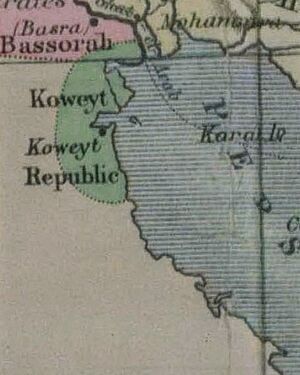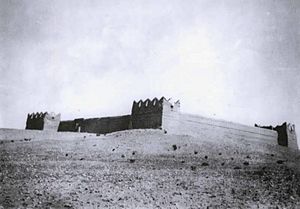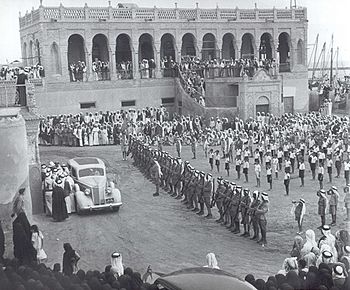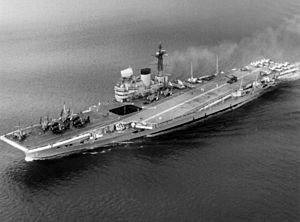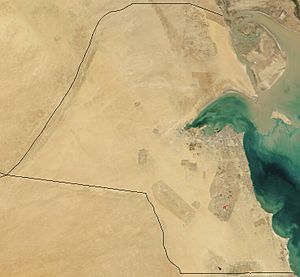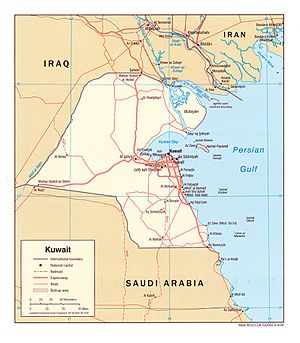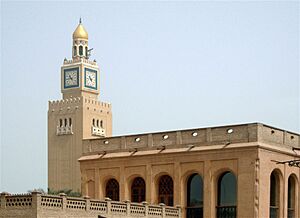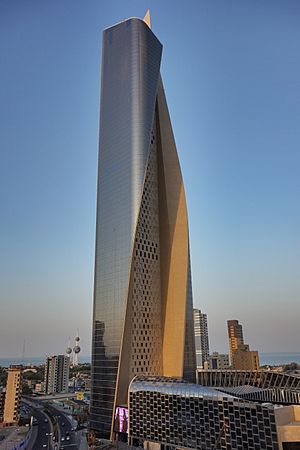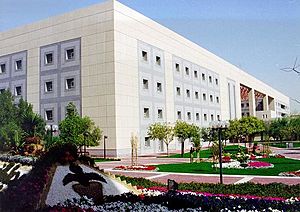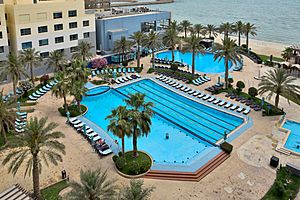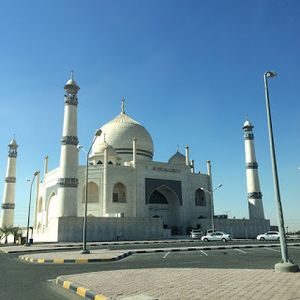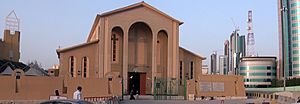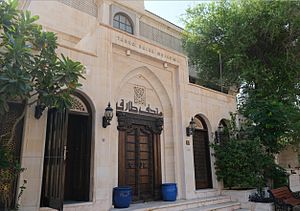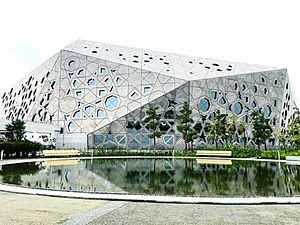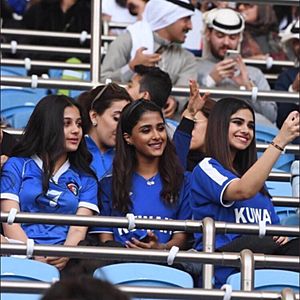Kuwait facts for kids
Quick facts for kids
State of Kuwait
|
|
|---|---|
|
|
|
|
Anthem: ٱلنَّشِيد ٱلْوَطَنِيّ
Al-Nashīd al-Waṭanī "National Anthem" |
|

Location of Kuwait (green)
|
|
| Capital and largest city
|
Kuwait City |
| Official languages | Arabic |
| Other languages | English (lingua franca) • Tagalog • Gulf Pidgin Arabic (lingua franca) • Hindi • Persian • Bengali • Urdu • French • Malayalam • Pashto • Turkish • Armenian • Kurdish • Other minority languages spoken |
| Ethnic groups
(2018)
|
|
| Religion
(2013)
|
|
| Demonym(s) | Kuwaiti |
| Government | Unitary semi-constitutional monarchy |
|
• Emir
|
Mishal Al-Ahmad Al-Jaber Al-Sabah |
| Sabah Al-Khalid Al-Sabah | |
| Ahmad Al-Abdullah Al-Sabah | |
| Legislature | The National Assembly Emergency clauses invoked; suspended for the next four years |
| Establishment | |
|
• Sheikhdom of Kuwait
|
1752 |
|
• Anglo-Kuwaiti Agreement
|
23 January 1899 |
|
• Anglo-Ottoman Convention
|
29 July 1913 |
|
• End of treaties with the United Kingdom
|
19 June 1961 |
| 14 May 1963 | |
|
• Current Constitution
|
11 November 1962 |
|
• Kuwait Governorate
|
28 August 1990 |
|
• Restoration of Current Constitution
|
28 February 1991 |
| Area | |
|
• Total
|
17,818 km2 (6,880 sq mi) (152nd) |
|
• Water (%)
|
negligible |
| Population | |
|
• 2024 estimate
|
3,138,355 (137th) |
|
• Density
|
200.2/km2 (518.5/sq mi) (62nd) |
| GDP (PPP) | 2024 estimate |
|
• Total
|
|
|
• Per capita
|
|
| GDP (nominal) | 2024 estimate |
|
• Total
|
|
|
• Per capita
|
|
| HDI (2022) | very high · 49th |
| Currency | Kuwaiti dinar |
| Time zone | UTC+3 (AST) |
| Date format | dd/mm/yyyy |
| Driving side | left |
| ISO 3166 code | KW |
| Internet TLD | .kw |
|
|
Kuwait is a small country in the Middle East. It covers about 17,819 square kilometers.
Kuwait is known as a very open country in the Persian Gulf area. It has a small but very rich economy. Kuwait has huge amounts of crude oil underground. These oil reserves are about 96 billion barrels. This means Kuwait holds 10% of all the world's oil reserves!
The country earns a lot of money by selling this oil. Oil sales make up almost half of all the money the country earns. It also accounts for 95% of what Kuwait sells to other countries (called exports). Plus, 80% of the government's money comes from oil. Kuwait is now working with other countries' oil companies to develop more oil fields.
Kuwait's dry weather makes farming difficult because there is little rain. So, the country focuses on catching fish. It also buys most of its food from other nations. About 75% of Kuwait's drinking water needs to have salt removed (a process called distillation). Or, it must be bought from other countries.
In 1990, Iraq sent its army to fight against Kuwait. This event started the first Gulf War. Kuwait's main religion is Islam. However, about 15% of its people are Christian or Hindu. Arabic is the main language, but many people in Kuwait also speak English. Kuwait is one of the few countries that offers education for people of all ages.
Contents
Kuwait's Long History
Historically, much of what is now Kuwait was part of ancient Mesopotamia.
Ancient Civilizations in Kuwait
People from Mesopotamia first settled on Failaka Island in Kuwait around 2000 B.C. Traders from the Sumerian city of Ur lived on Failaka. They ran a trading business there. The island had many Mesopotamian-style buildings from that time.
From 4000 BC to 2000 BC, Kuwait was home to the Dilmun civilization. This civilization included areas like Al-Shadadiya, Akkaz, Umm an Namil, and Failaka. At its peak around 2000 BC, Dilmun controlled the important trading routes in the Persian Gulf.
During the Dilmun era, Failaka was called "Agarum". It was known as the land of Enzak, a great god in the Dilmun civilization. This is known from ancient Sumerian writings found on the island. After Dilmun, Failaka was taken over by the Kassites from Mesopotamia. They were part of the Kassite dynasty of Babylon. People have lived on Failaka from the late 3rd millennium BC until the 20th century AD. Many old items found on Failaka are linked to Mesopotamian cultures. This shows that Failaka slowly became more connected to the civilization in Antioch.
Kuwait Under Babylonian and Persian Rule
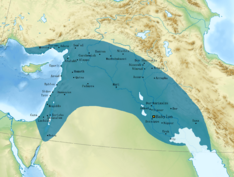
Under Nebuchadnezzar II, the area around Kuwait Bay was controlled by Babylonia. Ancient writings found on Failaka show that Babylonians lived on the island. Babylonian kings had governors in Failaka during the Neo-Babylonian Empire. Nebuchadnezzar II even had a palace and temple there. Failaka also had temples for Shamash, the Mesopotamian sun god.

After the Fall of Babylon, the Kuwait Bay area came under the control of the Achaemenid Empire (around 550–330 BC). The area was settled again after being empty for 700 years. Digs have found signs of Achaemenid presence on Failaka. Ancient Aramaic writings also confirm their presence.
Greek and Parthian Influence
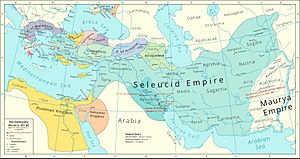
In the 4th century BC, the ancient Greeks settled in Kuwait Bay. This happened under Alexander the Great. The Greeks called mainland Kuwait Larissa. Failaka Island was named Ikaros. The bay itself was called Hieros Kolpos. Alexander the Great named Failaka "Ikaros" because it looked like the Aegean island of the same name. Large Greek forts and temples have been found. Other Greek settlement remains were found in Akkaz, Umm an Namil, and Subiya.
Around 127 BC, Kuwait became part of the Parthian Empire. The kingdom of Characene was set up around Teredon in what is now Kuwait. Characene coins have been found in Akkaz, Umm an Namil, and Failaka. A busy Parthian trading post was located in Kuwait.
The first time Kuwait was written about was in 150 AD. This was in a book called Geography by the Greek scholar Ptolemy. He called Kuwait Bay Hieros Kolpos.
Sassanid Empire and Early Islam
In 224 AD, Kuwait became part of the Sassanid Empire. At that time, Kuwait was known as Meshan. This was another name for the kingdom of Characene. Akkaz was a site from both Parthian and Sassanian times. A Sassanid religion's tower of silence was found in northern Akkaz. Later Sassanian settlements were found in Failaka. On Bubiyan Island, there is evidence of human presence from the Sassanian to early Islamic periods.
In 636 AD, the Battle of Chains happened in Kuwait. It was fought between the Sassanid Empire and the Rashidun Caliphate. At that time, Kuwait was under Sassanid control. This battle was the first time the Muslim army tried to expand its borders.
After the Rashidun victory in 636 AD, Kuwait Bay became home to the city of Kazma in the early Islamic era. Old Arabic writings mention Kuwait Bay often during this time. Kazma was a trade port and a resting place for pilgrims traveling from Iraq to Hejaz. The city was controlled by the kingdom of Al-Hirah in Iraq. In the early Islamic period, Kuwait Bay was known for being a fertile area. Kazma was also a stop for caravans coming from Persia and Mesopotamia. The famous poet Al-Farazdaq was born in Kazma.
Christian settlements thrived across Kuwait Bay from the 5th to the 9th century. Digs have found farms, villages, and two large churches from the 5th and 6th centuries. Remains of Byzantine-era churches were found in Akkaz and Al-Qusur.
Founding of Modern Kuwait (1521–1918)
In 1521, Kuwait was under Portuguese control. In the late 1500s, the Portuguese built a fort in Kuwait. In 1613, Kuwait City was founded as a fishing village. It was ruled by local leaders called sheikhs from the Bani Khalid clan. Later, in the early 1700s, the Bani Utbah group settled in Kuwait City. They eventually took control of Kuwait.
In the early 18th century, Kuwait became a busy port city. It quickly grew into a main trading center. Goods were moved between Baghdad, India, Muscat, and the Arabian Peninsula. By the mid-1700s, Kuwait was a major trade route from the Persian Gulf to Aleppo.
During the Persian siege of Basra (1775–79), Iraqi traders came to Kuwait for safety. This helped Kuwait's boat-building and trading grow a lot. Kuwait's sea trade boomed. Trade routes to Baghdad, Aleppo, and other cities were redirected to Kuwait. The East India Company also started using Kuwait in 1792. They made sure sea routes between Kuwait, India, and East Africa were safe. Even after the Persians left Basra in 1779, Kuwait kept attracting trade away from Basra.
Kuwaiti writers say that problems in Basra helped Kuwait's economy grow. In the late 1700s, Kuwait was a safe place for Basra merchants escaping the Ottoman rulers. Kuwait was the main place for boat building in the Persian Gulf. Its ships were famous across the Indian Ocean. Kuwaitis were also known as the best sailors in the Persian Gulf. In the 1800s, Kuwait became important in the horse trade. About 800 horses were sent to India each year.
In the 1890s, the Ottoman Empire was a threat. So, the ruler Sheikh Mubarak Al Sabah signed a deal with the British government. This deal, known as the Anglo-Kuwaiti Agreement of 1899, made Kuwait a British protectorate. This meant Britain had special access to trade with Kuwait. The Sheikhdom of Kuwait stayed a British protectorate until 1961.
During Mubarak's rule, Kuwait was called the "Marseilles of the Persian Gulf." This was because its strong economy attracted many different people. The population was diverse, with Arabs, Persians, Africans, Jews, and Armenians. Kuwait was known for its religious tolerance.
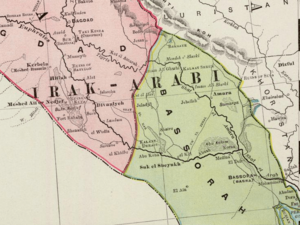
After the Anglo-Ottoman Convention of 1913, Kuwait became an independent kaza, or district, of the Ottoman Empire. It was also a de facto protectorate of Great Britain.
In the early 1900s, Kuwait had a strong group of wealthy families. They were connected by marriage and shared business interests. These families had lived in the city for a long time. The richest were merchants who earned their money from long-distance trade, shipbuilding, and pearl diving. They traveled a lot to India, Africa, and Europe. They also sent their sons to study abroad. Visitors noted that Kuwaiti leaders used European office systems and typewriters. They were also curious about European culture. The richest families were involved in general trade. Some Kuwaiti merchant families were worth millions before the 1940s.
In the early 20th century, Kuwait's economic importance in the region dropped a lot. This was mainly due to trade blockades and a global economic downturn. Before 1934, Kuwait lost its leading role in long-distance trade. During World War I, the British Empire blocked trade with Kuwait. This was because Kuwait's ruler, Salim Al-Mubarak Al-Sabah, supported the Ottoman Empire. The British blockade severely hurt Kuwait's economy.
After World War I (1919–1945)
The Kuwait–Najd War (1919–20) happened after World War I. The war started because Ibn Saud of Najd wanted to take over Kuwait. This conflict led to the deaths of hundreds of Kuwaitis. There were small border fights throughout 1919–1920.
After the war, Ibn Saud stopped trade with Kuwait from 1923 to 1937. Saudi Arabia's goal was to take as much of Kuwait's land as possible. At the Uqair conference in 1922, the borders of Kuwait and Najd were set. Kuwait had no representative at this conference due to British involvement. After the conference, Kuwait still faced a Saudi trade blockade and occasional attacks.
Throughout the 1930s, many Kuwaitis did not like the British decision to separate Kuwait from Iraq. In 1938, the "Free Kuwaiti Movement" was started by young Kuwaitis. They were against British rule. They asked the Iraqi government to reunite Kuwait and Iraq. Because of fears of an uprising, the Al Sabah rulers agreed to create a council. This council represented the "Free Kuwaiti Movement." Its first meeting in 1938 called for Kuwait and Iraq to be reunited.
Building a Modern State (1946–1982)
Between 1946 and 1982, Kuwait became very rich. This was thanks to its oil and open society. People often call these years the "Golden Era of Kuwait." In 1950, a big public works program started. This helped Kuwaitis have a modern way of life. By 1952, Kuwait was the biggest oil exporter in the Persian Gulf. This huge growth brought many foreign workers, especially from Palestine, India, and Egypt. In 1952, the first plan for Kuwait City was designed by a British firm.
In June 1961, Kuwait became an independent country. The British protectorate ended. Sheikh Abdullah Al-Salim Al-Sabah became the Emir of Kuwait.
In the 1960s and 1970s, Kuwait was seen as the most developed country in the region. Kuwait was a leader in finding ways to earn money besides oil. The Kuwait Investment Authority was the world's first government investment fund. From the 1970s onwards, Kuwait had the highest Human Development Index score among Arab countries. Kuwait University was founded in 1966. Kuwait's theatre industry was famous throughout the Arab world.
Kuwait Today
Even with some political issues, Kuwait had the highest Human Development Index in the Arab world from 2006 to 2009. China gave the Kuwait Investment Authority an extra $700 million for investments. This was on top of $300 million given earlier. This is the largest amount China has given to foreign investors.
As part of the Belt and Road Initiative, Kuwait and China are working on projects together. One is South al-Mutlaa, a city being built in northern Kuwait. The Sheikh Jaber Al-Ahmad Al-Sabah Causeway is part of the first phase of the Silk City project. This causeway opened in May 2019. It connects Kuwait City to northern Kuwait. This project is part of Kuwait's Vision 2035 plan.
Kuwait currently has the largest US military presence in the Middle East. Over 14,000 US military people are stationed there. Camp Arifjan is the biggest US military base in Kuwait. The US uses bases in Kuwait for staging, training, and support for its operations in the Middle East.
Kuwait's Geography and Environment
Kuwait is in the northeast corner of the Arabian Peninsula. It is one of the smallest countries in the world by land area. Kuwait is mostly flat. Its highest point is Mutla Ridge, which is 306 meters (1,004 feet) above sea level.
Kuwait has ten islands. Bubiyan Island is the largest, covering 860 square kilometers (332 square miles). It is connected to the mainland by a 2,380-meter (7,808-foot) bridge. Only 0.6% of Kuwait's land can be farmed. There is not much plant life along its 499-kilometer (310-mile) coastline. Kuwait City is located on Kuwait Bay, which is a natural deep-water harbor.
Kuwait's Burgan field has about 70 billion barrels of proven oil reserves. During the Kuwaiti oil fires in 1991, over 500 oil lakes formed. These covered about 35.7 square kilometers (13.8 square miles). The oil and soot made parts of eastern and southeastern Kuwait unlivable. Sand and oil turned large parts of the desert into hard, asphalt-like surfaces. The oil spills during the Gulf War also greatly harmed Kuwait's sea life.
Kuwait's Climate
Kuwait is close to Iraq and Iran. This makes its winters colder than other coastal countries in the region, like UAE, Qatar, and Bahrain. Kuwait is also less humid. Spring in March is warm with some thunderstorms. Winds from the northwest are cold in winter and hot in summer. Damp winds from the southeast blow between July and October. Hot, dry south winds are common in spring and early summer. The shamal, a northwest wind in June and July, causes big sandstorms. Summers in Kuwait are among the hottest on Earth. The highest temperature ever recorded in Asia was 54.0 °C (129.2 °F) in Mitribah on July 21, 2016.
Kuwait emits a lot of carbon dioxide per person. In recent years, Kuwait has often been ranked among the highest countries for CO2 emissions per person.
Nature Reserves in Kuwait
Kuwait has five protected areas recognized by the IUCN. Bubiyan Island's Mubarak al-Kabeer reserve is Kuwait's first Wetland of International Importance. This happened when Kuwait joined the Ramsar Convention. The reserve is 50,948 hectares (125,895 acres). It has small lagoons and shallow salt marshes. It is an important stop for migrating birds. The reserve is home to the world's largest group of breeding crab-plovers.
Wildlife in Kuwait
 There are 444 types of birds recorded in Kuwait. Eighteen of these species breed in the country. The arfaj is Kuwait's national flower. Kuwait is located where many major bird migration routes cross. Between two and three million birds pass through each year. Kuwait's marine and coastal areas hold most of the country's diverse wildlife. The marshes in northern Kuwait and Jahra are becoming more important for migrating birds.
There are 444 types of birds recorded in Kuwait. Eighteen of these species breed in the country. The arfaj is Kuwait's national flower. Kuwait is located where many major bird migration routes cross. Between two and three million birds pass through each year. Kuwait's marine and coastal areas hold most of the country's diverse wildlife. The marshes in northern Kuwait and Jahra are becoming more important for migrating birds.
Twenty-eight types of mammals live in Kuwait. Animals like gerboas, desert rabbits, and hedgehogs are common in the desert. Large meat-eaters like the wolf, caracal, and jackal are no longer found there. Endangered mammals include the red fox and wild cat. Forty types of reptiles have been recorded. None of them are found only in Kuwait.
Kuwait, Oman, and Yemen are the only places where the endangered smoothtooth blacktip shark is known to live.
Kuwaiti islands are important places for four types of terns and the socotra cormorant to breed. Kubbar Island is an Important Bird Area (IBA). It has a large breeding colony of white-cheeked terns.
Water and Sanitation in Kuwait
Kuwait is part of the Tigris–Euphrates river system basin. Some parts of the Kuwait–Iraq border are formed by where the Tigris and Euphrates rivers meet. Bubiyan Island is part of the Shatt al-Arab delta. Kuwait is also partly in the Mesopotamian Marshes.
Kuwait does not have any permanent rivers. However, it has several wadis, which are dry riverbeds. The most famous is Wadi al-Batin, which forms the border between Kuwait and Iraq. Kuwait also has river-like sea channels around Bubiyan Island. One is Khawr Abd Allah, which is now an estuary. It used to be where the Shatt al-Arab flowed into the Persian Gulf. Khawr Abd Allah is in southern Iraq and northern Kuwait.
Kuwait gets its fresh water mainly from desalination. This process removes salt from seawater for drinking and home use. There are more than six desalination plants. Kuwait was the first country to use desalination to provide water for many people. The first plant was built in 1951.
In 1965, the Kuwaiti government hired a Swedish company to plan a modern water-supply system for Kuwait City. The company built five groups of water towers, with 31 towers in total. For a sixth site, the Emir of Kuwait, Sheikh Jaber Al-Ahmed, wanted a more special design. This group, known as Kuwait Towers, has three towers. Two of them are also water towers. Water from the desalination plants is pumped up to these towers. The 33 towers can hold 102,000 cubic meters of water. The "Water Towers" won an award for their design in 1980.
Kuwait's fresh water sources are limited to groundwater, desalinated seawater, and treated wastewater. Most water needs are met by desalination plants. Sewage is handled by a national system that covers 98% of the country.
How Kuwait is Governed
Kuwait is an emirate. The Emir is the head of state. He belongs to the Al Sabah ruling family. The government has an appointed cabinet and a court system. Kuwait's Constitution of Kuwait was put in place in 1962.
The government carries out the laws. The Emir chooses the prime minister. The prime minister then picks the cabinet of ministers.
The Emir also appoints the judges. The Constitutional Court decides if laws and rules follow the constitution. Kuwait has an active public life. There are many political and social groups. Professional groups, like the Chamber of Commerce, are independent from the government. They represent Kuwaiti businesses.
The Emir has the power to make laws. This power used to be shared with the National Assembly. According to Kuwait's constitution, the Emir can dissolve the assembly. If he does, new elections must be held within two months.
Kuwaiti women are considered among the most independent women in the Middle East. In 2014 and 2015, Kuwait was ranked first among Arab countries in the Global Gender Gap Report. In 2013, 53% of Kuwaiti women were part of the workforce. They outnumbered working Kuwaiti men. This gives Kuwait the highest female citizen participation in the workforce among Gulf Cooperation Council (GCC) countries.
According to the Social Progress Index, Kuwait ranks first in social progress in the Arab and Muslim world. It is second highest in the Middle East after Israel. However, women's political involvement in Kuwait has been limited. Despite many attempts to give Kuwaiti women the right to vote, they did not get it permanently until 2005.
Kuwait ranks high globally in life expectancy. It also ranks high in women's workforce participation, global food security, and school order and safety.
Kuwait's Economy
Kuwait is one of the richest countries in the world. The Kuwaiti dinar is the highest-valued currency unit globally. The World Bank says Kuwait is the fifth richest country in the world by gross national income per person. It is one of only five nations with a GNI per person above $70,000.
In the last five years, there has been a big increase in new businesses and small companies starting up in Kuwait.
Kuwait's main exports are mineral fuels, mostly oil (89.1% of all exports). Other exports include aircraft (4.3%), chemicals (3.2%), plastics (1.2%), and iron and steel (0.2%). Kuwait was the world's biggest exporter of certain types of hydrocarbons in 2019. In 2019, Kuwait was ranked 63rd out of 157 countries in the Economic Complexity Index (ECI).
Science and Technology in Kuwait
Kuwait has a growing area of scientific research. As of December 31, 2015, Kuwait was the second largest producer of patents in the Arab world. Kuwait was ranked 64th in the Global Innovation Index in 2023.
Kuwait was the first country in its region to use 5G technology. Kuwait is among the world's top markets for 5G use.
Education in Kuwait
Kuwait had the highest literacy rate in the Arab world in 2010. The education system has four levels:
- kindergarten (2 years)
- primary (5 years)
- intermediate (4 years)
- secondary (3 years)
Schooling at primary and intermediate levels is required for all students aged 6–14. All levels of state education, including higher education, are free. The public education system is being updated with help from the World Bank.
After high school, students can take technical and vocational courses. These are offered by the Public Authority for Applied Education and Training (PAAET). They can also get degrees from Kuwait University and 14 private universities.
Tourism in Kuwait
In 2020, people in Kuwait spent $6.1 billion on travel and tourism within the country. This was up from $1.6 billion in 2019. Family tourism is growing fast. The WTTC named Kuwait as one of the fastest-growing countries in travel and tourism GDP in 2019. It grew by 11.6% year-on-year. In 2016, tourism brought in almost $500 million. In 2015, tourism made up 1.5% of Kuwait's GDP. Sabah Al Ahmad Sea City is one of Kuwait's biggest attractions.
The Amiri Diwan recently opened the new Kuwait National Cultural District (KNCD). This includes the Sheikh Abdullah Al Salem Cultural Centre, Sheikh Jaber Al Ahmad Cultural Centre, Al Shaheed Park, and Al Salam Palace. This project cost over US$1 billion. It is one of the largest cultural investments in the world. The Kuwait National Cultural District is part of the Global Cultural Districts Network. Al Shaheed Park is the largest green roof project ever built in the Arab world.
The yearly "Hala Febrayer" festival brings many tourists from nearby GCC countries. It includes music concerts, parades, and carnivals. The festival lasts for a month, from February 1 to 28. It celebrates the liberation of Kuwait. Liberation Day itself is on February 26.
People and Culture in Kuwait
Population and Languages
In 2018, Kuwait had 4.6 million people. Of these, 1.8 million were Kuwaitis. There were 800,000 other Arabs, 1.6 million Asian workers, and 47,227 Africans.
Kuwait's official language is Modern Standard Arabic. However, it is mostly used in news and education. Kuwaiti Arabic is the version of Arabic used in daily life. English is widely understood and often used for business. Besides English, French is taught as a third language to humanities students in schools, but only for two years.
Religion in Kuwait
Kuwait's official state religion is Maliki Sunni Islam. Kuwait also has many people from other countries who are Christians, Hindus, Buddhists, and Sikhs.
Kuwaiti Food
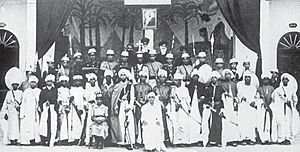
Kuwaiti food mixes Arabian, Iranian, and Mesopotamian styles. It is part of the Eastern Arabian cuisine. A famous Kuwaiti dish is machboos. This is a rice dish usually made with basmati rice, spices, and chicken or mutton.
Seafood is a big part of the Kuwaiti diet, especially fish. Mutabbaq samak is a national dish in Kuwait. Other local favorites are hamour (grouper), often grilled, fried, or served with biryani rice. Also popular are safi (rabbitfish), maid (mulletfish), and sobaity (sea bream).
Kuwait's traditional flatbread is called Iranian khubz. It is a large flatbread baked in a special oven. It is often topped with sesame seeds. Many local bakeries are found across the country. The bakers are mainly Iranians, which is why the bread is called "Iranian khubuz." Bread is often served with mahyawa fish sauce.
Arts and Entertainment
Kuwaiti popular culture, including theatre, radio, music, and TV shows, is very active. It is even sent to nearby countries. Among the Arab states of the Persian Gulf, Kuwait's culture is most similar to Bahrain's. This is seen in how closely they work together on plays and TV shows.
Museums in Kuwait
The new Kuwait National Cultural District (KNCD) has many cultural places. These include the Sheikh Abdullah Al Salem Cultural Centre, Sheikh Jaber Al Ahmad Cultural Centre, Al Shaheed Park, and Al Salam Palace. This project cost over US$1 billion. It is one of the largest cultural districts in the world. The Abdullah Salem Cultural Centre is the biggest museum complex in the Middle East. The Kuwait National Cultural District is a member of the Global Cultural Districts Network.
Sadu House is one of Kuwait's most important cultural places. Bait Al-Othman is the largest museum focused on Kuwait's history. The Scientific Center is one of the biggest science museums in the Middle East. The Museum of Modern Art shows the history of modern art in Kuwait and the region. The Kuwait Maritime Museum displays the country's sea heritage from before oil was discovered. Several old Kuwaiti dhow ships are open to the public. These include Fateh Al-Khayr and Al-Hashemi-II. The Al-Hashemi-II is in the Guinness Book of World Records as the largest wooden dhow ever built. The Historical, Vintage, and Classical Cars Museum shows old cars from Kuwait's history. The National Museum, opened in 1983, has been described as "underused."
Several Kuwaiti museums are dedicated to Islamic art. The most notable are the Tareq Rajab Museums and Dar al Athar al Islamiyyah cultural centers. These centers have education areas, labs for preserving art, and research libraries. There are several art libraries in Kuwait. Khalifa Al-Qattan's Mirror House is the most popular art museum in Kuwait. Many museums in Kuwait are privately owned. Unlike other Gulf states, Kuwait's museum growth shows a stronger sense of community. It also shows the strength of its civil society, which has created many independent cultural projects.
Sports in Kuwait
Football is the most popular sport in Kuwait. The Kuwait Football Association (KFA) manages football in Kuwait. The KFA organizes the men's, women's, and futsal national teams. The Kuwaiti Premier League is the top football league in Kuwait, with eighteen teams. The Kuwait national football team won the 1980 AFC Asian Cup. They were runners-up in 1976 and took third place in 1984. Kuwait also went to one FIFA World Cup, in 1982. They tied 1–1 with Czechoslovakia but lost to France and England, so they did not move past the first round.
Kuwait has many football clubs, including Al-Arabi, Al-Fahaheel, Al-Jahra, Al-Kuwait, Al-Naser, Al-Salmiya, Al-Shabab, Al Qadsia, Al-Yarmouk, Kazma, Khaitan, Sulaibikhat, Sahel, and Tadamon. The biggest football rivalry in Kuwait is between Al-Arabi and Al Qadsia.
Basketball is also very popular. The Kuwait national basketball team is managed by the Kuwait Basketball Association (KBA). Kuwait first played internationally in 1959. The national team has been to the FIBA Asian Championship eleven times. The Kuwaiti Division I Basketball League is the top professional basketball league. Cricket in Kuwait is managed by the Kuwait Cricket Association. Other growing sports include rugby union. Handball is often seen as Kuwait's national sport, even though football is more popular overall.
Ice hockey in Kuwait is managed by the Kuwait Ice Hockey Association. Kuwait first joined the International Ice Hockey Federation in 1985. But it was removed in 1992 because there was not enough ice hockey activity. Kuwait was allowed back into the IIHF in May 2009. In 2015, Kuwait won the IIHF Challenge Cup of Asia.
In February 2020, Kuwait hosted a part of the UIM Aquabike World Championship for the first time. It took place in front of Marina Beach City.
In May 2022, Kuwait hosted the Third Gulf Cooperation Council (GCC) Games at the 360 Marina. The event had 16 different sports. These included volleyball, basketball, swimming, athletics, karate, and judo. Over 1,700 male and female players took part.
Administrative Divisions
Kuwait is divided into six governorates:
- Al Asimah Governorate (or Capital Governorate)
- Hawalli Governorate
- Farwaniya Governorate
- Mubarak Al-Kabeer Governorate
- Ahmadi Governorate
- Jahra Governorate
These governorates are further divided into smaller areas.
Related Pages
Images for kids
See also
 In Spanish: Kuwait para niños
In Spanish: Kuwait para niños






